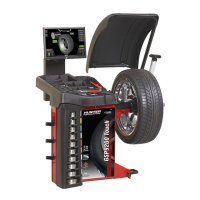44 BALANCING PROCEDURES
3.11 Blinding and Rounding
In non-SmartWeight mode the balancer can display
either an “actual” or “blinded and rounded” amount of
imbalance.
“Blind” is a tolerance or amount of imbalance required
before an imbalance amount is displayed. “Round” allows
the balancer to display weight imbalance to a desired
increment. The blind and round values can be changed in
the “Setup” procedure.
While in the “Balance” primary screen, blind and rounding
may be disabled by touching the screen to highlight the
magnifying glass. The actual amounts of imbalance for
the selected mode will be displayed when “Blind and
Rounding” are disabled as shown below.
Dynamic mode, blinding/rounding is disabled:
Figure 172.
Static mode, blinding/rounding is enabled:
Figure 173.
Manual Weight Position Measurement
Touch the screen in the upper rim profile area to toggle
manual weight selection. The balancer will switch to
Manual Weight Selection mode.
Figure 169.
Touching the weight locations will change the weight
location planes.
Figure 170.
Automatic is the default setting, automatically choosing
the correct type of weights and locations determined by
the placement of the Dataset® arms. Hunter Engineering
Company recommends using the inner and outer
Dataset® arms to enter dimensions (Automatic).
Measuring Dimensions
Positioning the Auto Dataset® arms on the desired
weight planes and tapping the foot pedal will record
wheel dimension data.
Figure 171.

